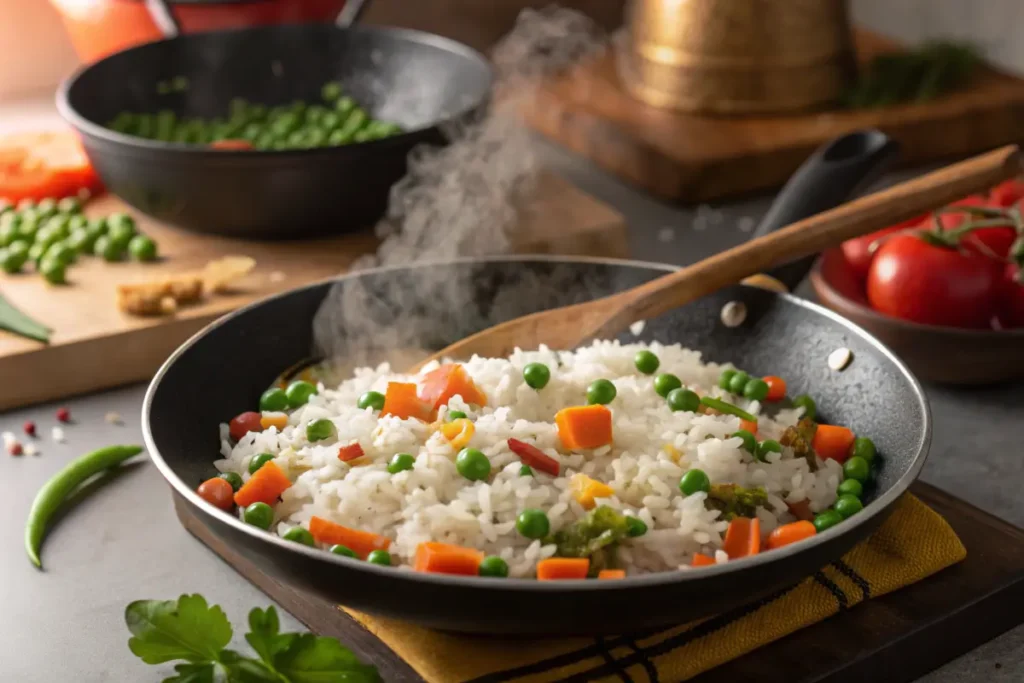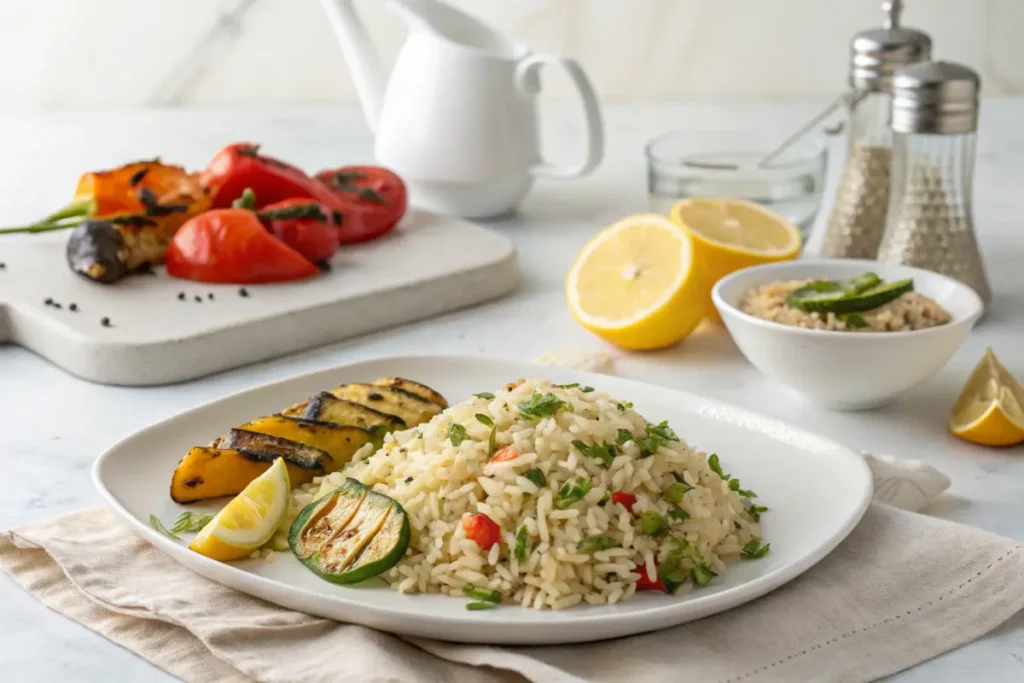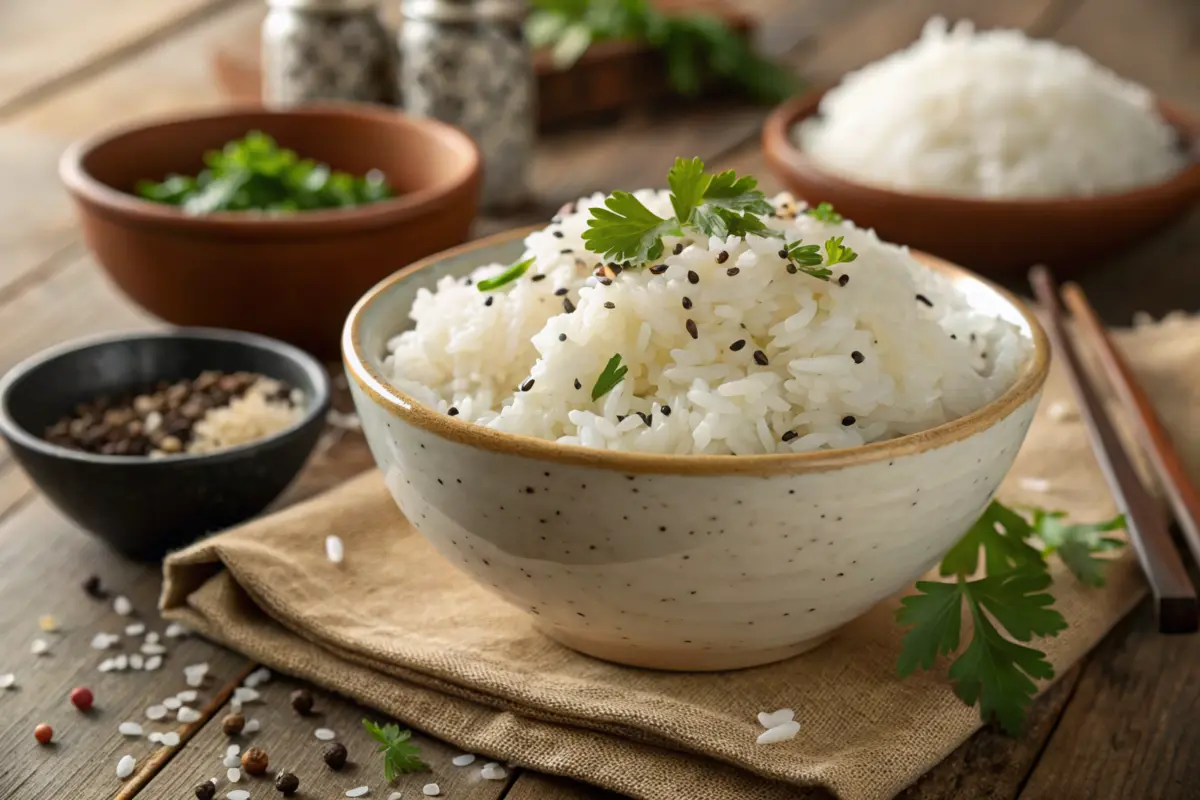White rice is a staple dish enjoyed worldwide, but on its own, it can sometimes taste a little plain. Enter seasonings, particularly pepper, which has the power to transform this humble grain into something truly delightful. In this article, we’ll explore the fascinating world of putting pepper on white rice, diving into its cultural significance, practical benefits, and delicious alternatives. Whether you’re a seasoned cook or a curious foodie, there’s plenty to uncover about this simple yet impactful pairing. Let’s begin!
Understanding the Use of Pepper in Culinary Practices
What Is Pepper and Its Culinary Significance?
Pepper, often referred to as the “king of spices,” has been a kitchen mainstay for centuries. Derived from the dried berries of the Piper nigrum plant, black pepper offers a bold, pungent flavor that enhances a variety of dishes. But why does it pair so well with white rice? The neutral taste of rice provides the perfect canvas for the sharp, spicy notes of pepper to shine, making it a go-to seasoning for many.
Beyond its flavor-enhancing properties, pepper boasts a rich history. Ancient traders considered it so valuable that it was sometimes used as currency. Today, it’s a household essential, elevating everything from soups to stir-fries—and yes, even plain white rice.
Historical Use of Pepper in Global Cuisines
Pepper’s influence spans the globe. In India, it’s a cornerstone of spice blends like garam masala. In Europe, it’s used to season everything from meat to pasta. Across the Americas, you’ll find it in marinades and rubs. When it comes to white rice, different cultures have their unique twists. For instance, in parts of Asia, rice dishes with a dash of pepper are a popular comfort food.
Interestingly, the practice of sprinkling pepper on rice stems from the need to enhance its flavor while maintaining simplicity. This tradition continues today, particularly in minimalist cooking styles where the ingredients’ natural qualities are celebrated.
White rice is a staple dish enjoyed worldwide, but on its own, it can sometimes taste a little plain. Enter seasonings, particularly pepper, which has the power to transform this humble grain into something truly delightful. In this article, we’ll explore the fascinating world of putting pepper on white rice, diving into its cultural significance, practical benefits, and delicious alternatives. Whether you’re a seasoned cook or a curious foodie, there’s plenty to uncover about this simple yet impactful pairing. Let’s begin!
Understanding the Use of Pepper in Culinary Practices
What Is Pepper and Its Culinary Significance?
Pepper, often referred to as the “king of spices,” has been a kitchen mainstay for centuries. Derived from the dried berries of the Piper nigrum plant, black pepper offers a bold, pungent flavor that enhances a variety of dishes. But why does it pair so well with white rice? The neutral taste of rice provides the perfect canvas for the sharp, spicy notes of pepper to shine, making it a go-to seasoning for many.
Beyond its flavor-enhancing properties, pepper boasts a rich history. Ancient traders considered it so valuable that it was sometimes used as currency. Today, it’s a household essential, elevating everything from soups to stir-fries—and yes, even plain white rice.
Historical Use of Pepper in Global Cuisines
Pepper’s influence spans the globe. In India, it’s a cornerstone of spice blends like garam masala. In Europe, it’s used to season everything from meat to pasta. Across the Americas, you’ll find it in marinades and rubs. When it comes to white rice, different cultures have their unique twists. For instance, in parts of Asia, rice dishes with a dash of pepper are a popular comfort food.
Interestingly, the practice of sprinkling pepper on rice stems from the need to enhance its flavor while maintaining simplicity. This tradition continues today, particularly in minimalist cooking styles where the ingredients’ natural qualities are celebrated.
Adding Pepper to White Rice: Cultural and Practical Perspectives
Cultural Practices: Pepper and Rice Combinations Worldwide
Throughout the globe, the combination of pepper and white rice has earned a place in culinary traditions. In Southeast Asia, dishes like pepper rice emphasize the harmony between the mild, nutty taste of rice and the bold heat of black pepper. In Creole and Cajun cooking, pepper is often a crucial seasoning for spiced rice dishes such as jambalaya.
Meanwhile, in minimalist European cuisines, a sprinkle of black pepper is used to enhance the simple flavor of plain boiled rice, often paired with grilled meats or fish. This widespread adoption reflects how pepper complements the versatility of white rice, allowing it to adapt to a multitude of flavor profiles across cuisines.
Practical Benefits of Adding Pepper to White Rice
The practical reasons behind seasoning rice with pepper are numerous. Firstly, pepper can elevate the blandness of plain white rice, making it a more enjoyable base for meals. Moreover, the spicy kick can stimulate appetite and digestion, a benefit long recognized in traditional medicine.
Additionally, pepper’s ability to bring out the flavors of accompanying ingredients means it can enhance the overall taste of a dish without overshadowing it. For example, a simple bowl of white rice becomes a gourmet experience when paired with butter, a pinch of salt, and a generous dash of freshly ground pepper.
The Science Behind Pepper and Rice
Flavor Pairing: How Pepper Enhances Rice’s Taste
Why does pepper work so well with white rice? The science lies in flavor pairing. White rice, with its subtle, starchy profile, acts as a neutral backdrop, allowing the sharp, piquant notes of pepper to stand out. Pepper contains piperine, a compound that stimulates taste buds, heightening the perception of flavor in other ingredients.
This balance is what makes dishes like pepper rice or stir-fried rice with black pepper sauce so satisfying. The sharpness of the spice offsets the soft texture of rice, creating a complementary interplay of taste and mouthfeel.
Nutritional Benefits of Pepper on White Rice
Adding pepper to white rice isn’t just about flavor—it’s also good for you. Black pepper is packed with antioxidants and has anti-inflammatory properties. Additionally, piperine is known to enhance nutrient absorption, making it a valuable addition to rice dishes paired with vegetables or proteins. Incorporating pepper into your diet with rice is an easy and delicious way to enjoy its health benefits.
How to Add Pepper to White Rice

Different Methods to Incorporate Pepper
Adding pepper to white rice is straightforward, but how you do it can significantly affect the flavor. One common method is to sprinkle freshly ground black pepper on cooked rice before serving. This technique is ideal for those who prefer the bold, zesty flavor of raw pepper.
For a more integrated taste, add pepper while cooking the rice. Mix it into the water or broth with a pinch of salt. This allows the spice to infuse into each grain, giving a subtle yet consistent flavor. Alternatively, sautéing cooked rice in butter or oil with ground pepper can create a fragrant, flavorful side dish.
Want to experiment? Consider using white or pink peppercorns for a milder taste, or crushed red pepper flakes for a spicy kick. These variations demonstrate the versatility of adding pepper to white rice.
Best Practices: Cooking Tips for Optimal Flavor
When seasoning rice with pepper, fresh is best. Use a grinder to crush whole peppercorns just before adding them to your dish. This ensures the pepper retains its robust aroma and pungent taste.
Balance is key; start with a small amount and adjust to taste. Too much pepper can overpower the delicate flavor of the rice. Pairing pepper with other mild seasonings like butter, garlic, or herbs can help create a more complex flavor profile.
If you enjoy experimenting with recipes, try combining rice and pepper with complementary dishes. For example, pair it with grilled vegetables or marinated meats to create a balanced meal.
Alternatives and Complements to Pepper for Rice Seasoning

Other Spices That Pair Well with White Rice
If you’re wondering, “Can you put pepper on white rice?”, the answer is a resounding yes, but it’s not your only option. For those seeking variety, spices like cumin, turmeric, and paprika are excellent alternatives. Each brings its unique flair to white rice, transforming it into a flavorful dish with minimal effort.
Cumin adds an earthy aroma, often used in Middle Eastern and Indian cuisines. Turmeric not only enhances the taste but also gives rice a beautiful golden hue. Paprika offers a smoky depth that pairs well with grilled or roasted foods. Mixing these spices with pepper can also create exciting flavor combinations.
Complementary Ingredients to Enhance Flavor
Seasoning rice with pepper doesn’t have to stop there. Combine it with complementary ingredients like fresh herbs, lemon zest, or a drizzle of sesame oil to elevate your dish further. Butter or olive oil provides a creamy base for the spices, while chopped garlic or shallots add a savory depth.
Vegetables like peas, carrots, and bell peppers also pair wonderfully with seasoned rice, creating a nutritious and vibrant meal. You can even add proteins like shredded chicken, shrimp, or tofu for a complete dish that satisfies.
For more seasoning inspiration, explore other articles on Creative Rice Recipes to discover unique pairings and flavors.
Common Mistakes When Adding Pepper to White Rice
Overuse of Pepper: Avoiding Overpowering the Dish
Seasoning white rice with pepper can make it more exciting, but overdoing it is a common mistake. The neutral flavor of rice can be easily overwhelmed by an excessive amount of pepper, leaving the dish overly spicy and unbalanced. Start small—just a pinch or a light sprinkle—and adjust to taste.
Remember, less is often more when it comes to seasoning simple dishes like white rice. If you’re tempted to add more pepper for a stronger flavor, consider pairing it with other mild seasonings like salt or butter to maintain harmony.
Choosing the Right Type of Pepper for White Rice
Another common mistake is not considering the type of pepper used. Freshly ground black pepper delivers a robust, sharp flavor, while pre-ground pepper can sometimes lack intensity. Opt for freshly ground pepper when possible, as it retains its oils and aroma better.
For those wondering, “Can you put pepper on white rice and still enjoy subtle flavors?”, the answer lies in using the right type. White or pink peppercorns offer milder options that blend seamlessly with rice, while red pepper flakes or Sichuan peppercorns are great for those who prefer heat or complexity. Understanding these differences ensures your dish turns out exactly how you want.
FAQs About Pepper and White Rice
Can Pepper Make White Rice Healthier?
Yes, adding pepper to white rice not only enhances its flavor but also provides health benefits. Black pepper contains piperine, a compound known to boost metabolism and improve nutrient absorption. Pairing it with nutrient-rich toppings like vegetables or lean proteins can create a balanced, flavorful meal.
What Types of Pepper Work Best for White Rice?
Black pepper is the most versatile option, but experimenting with others can lead to delightful surprises. White and pink peppercorns offer subtler flavors, while red pepper flakes bring heat. The choice depends on your personal preference and the dish you’re creating.
How Much Pepper Should Be Used?
The amount of pepper to add depends on your taste. Start with a light sprinkle, about 1/8 teaspoon per serving, and gradually increase if needed. Always taste as you go to avoid overpowering the rice’s natural flavor.
Can Other Spices Be Mixed with Pepper on Rice?
Absolutely! Pepper pairs wonderfully with spices like garlic powder, cumin, or paprika. Mixing these seasonings can elevate white rice from a simple side to a flavorful main component of your meal.
Creative Recipes Using Pepper and White Rice
Classic Pepper Rice with Butter and Herbs
If you’ve been asking, “Can you put pepper on white rice?”, a classic recipe is the perfect way to start. This simple yet flavorful dish involves mixing freshly ground black pepper with cooked white rice, a pat of butter, and a handful of chopped fresh herbs like parsley or cilantro. The butter adds richness, while the herbs provide a burst of freshness to balance the pepper’s kick.
For an extra twist, you can add grated parmesan or a squeeze of lemon juice. This recipe is ideal as a standalone dish or as a complement to grilled chicken or roasted vegetables.
Spicy Stir-Fried Pepper Rice
For those who enjoy a bold flavor, a spicy stir-fried pepper rice is a must-try. Start by sautéing garlic and onions in sesame oil until fragrant, then toss in cooked white rice. Add soy sauce, red pepper flakes, and a generous amount of black pepper for heat and depth. Top with a fried egg or sautéed shrimp for a complete meal.
This dish proves that pepper can transform plain white rice into a delicious, spicy comfort food that’s quick and easy to make. Feel free to customize it with vegetables or proteins of your choice.
Final Thoughts on Using Pepper with White Rice
Why Pepper and White Rice Are a Winning Combo
So, can you put pepper on white rice? Absolutely—and it’s a winning combination for good reason. Pepper brings out the subtle flavor of rice while adding a layer of complexity. This pairing is versatile, easy to prepare, and works well with countless cuisines. Whether it’s a simple sprinkle for added zest or a key ingredient in a creative recipe, pepper elevates rice to a whole new level.
Exploring New Ways to Enjoy Seasoned Rice
Don’t stop with just pepper! Experimenting with other seasonings and ingredients can unlock endless possibilities. Consider mixing in garlic, ginger, or curry powder for global-inspired flavors. Pair seasoned rice with fresh vegetables or lean proteins for a nutritious, balanced meal.
For more recipe ideas, check out our related article on Beef and Pepper Rice Recipe to discover how pepper can transform your dishes.
Conclusion
Pepper and white rice may seem like a simple pairing, but the possibilities are endless. From enhancing the flavor of plain rice to creating exciting, spiced dishes, pepper transforms this everyday staple into a versatile and flavorful component of any meal. So, can you put pepper on white rice? Without a doubt! Whether you prefer a subtle sprinkle or a bold, peppery kick, this combination offers something for every palate.
By exploring creative recipes, trying new seasoning combinations, and using pepper to elevate other ingredients, you’ll never look at white rice the same way again. Simple, nutritious, and endlessly adaptable, seasoned rice is a culinary canvas waiting for your touch. Grab some pepper, cook up some rice, and let your imagination guide you to delicious results.

